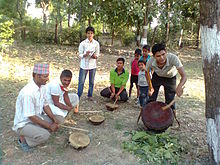Damai
दमाइँ/ढोली | |
|---|---|
 Damai men playing traditional Damaha | |
| 4,72,862 (1.8% of Nepal's population) [1] | |
| Languages | |
| Nepali language (Khas kura) | |
| Religion | |
| Related ethnic groups | |
| Khas people, Kami, Badi, Sarki, Gandarbha/Gaine |
Damai/Dholi (Nepali: दमाइँ) is a occupational caste found among Khas people.[2] People belonging to this caste are traditionally tailors[2] and musicians. Damai is coined from musical instrument Damaha while Dholi is coined from the instrument Dhol. The 1854 Nepalese Muluki Ain (Legal Code) categorized Damai as "Impure and Untouchable (Pani Na Chalne)" category.[3] Thus, the tribal designation of Khas is given only in few context to Kami, Damai and Sarki due to traditional low and untouchable status.[2]
According to 2011 Nepal census, Damai or Dholi make up 1.8% of Nepal's population (or 4,72,862 peoples).[1] Damai are categorized under "Hill Dalit" among the 9 broad social groups, along with Kami, Badi, Sarki and Gaine by the Government of Nepal.[1]
References
- ^ a b c "Nepal Census 2011" (PDF).
- ^ a b c Whelpton 2005, p. 31.
- ^ Gurung, Harka (2005) Social Exclusion and Maoist Insurgency. Paper presented at National Dialogue Conference at ILO Convention 169 on Indigenous and Tribal peoples, Kathmandu, 19–20 January 2005.
Bibliography
- Whelpton, John (2005). A History of Nepal. Cambridge University Press. ISBN 978-0521804707.
{{cite book}}: Invalid|ref=harv(help)
